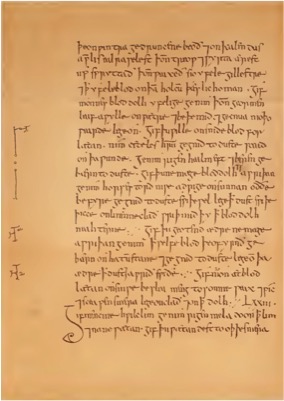Still poorly understood
The Anglo Saxon period, from 410AD when the Romans left Britain until 1060 has been called the Dark Ages but there is a surprising amount of Anglo Saxon literature, including over 1000 pages of medical texts. Some are translations or copies from Greek and Latin, but some are clearly Anglo Saxon in origin, giving us a tantalising glimpse into the work of the Anglo Saxon doctor.
over 1000 pages of medical texts. Some are translations or copies from Greek and Latin, but some are clearly Anglo Saxon in origin, giving us a tantalising glimpse into the work of the Anglo Saxon doctor.
The Leechbooks of Bald (pictured) were compiled about 900AD, in the reign of King Alfred and were commissioned by Bald, presumably a doctor (or rather, a Leech!). A digital facsimile is now available at the British Library.
Click here to view the digital version
Dietary Factors
The diet of the Anglo-Saxons was poor and it is likely that many suffered from urinary calculi. Stone disease was mentioned in the Leechbooks; the Anglo-Saxon word for bladder pain was blaedderwaerc. A treatment for bladder stones was meadow saxifrage boiled in ale with parsley; an alternative treatment was to eat a roasted starling with boiled wood-marche.
Treatment of Urinary Symptoms
For urinary retention, other herbs were suggested such as cumin, nigella, yarrow and fennel, invariably steeped in a bowl of wine, but also given were, sodden rams bladders, roasted goose tongues and a roasted fish within fish. The treatment for urinary incontinence was the ashes of burnt boar claws or, alternatively, a fried goat’s bladder. Perhaps a little more palatable was the remedy for haematuria which was dog roses in water or ale.
For pain “where the kidneys are lodged”, the Leech was instructed to:
... wave him strongly ... and say thrice, 'Remedium facio ad ventris dolorem' ...
then to throw the beetle over his shoulder without looking back. This "Harry Potter-esque" approach was supposed to give the Leech’s hand the power to heal renal pain for a year. This was clearly magic and formed one part of Anglo-Saxon medicine. Indeed, the Leech's ring finger was known as the "leech finger" and was the finger with which they touched the sick spot in order to cure the illness.
Magic or Placebo?
We know that faith can be a great healer and, in Anglo Saxon times, this could mean magic or Christianity. Both were clearly used although the Bishops forbade the use of magic charms in medicine.
I expect you have all seen a patient with ureteric colic who will recall the fear instilled by this excruciating agony - a pain that comes seemingly from nowhere. The Saxons believed that this sudden loin pain, with no obvious cause, could only be due to the invisible arrows of elves, or elf shot. Again, the treatment was magical; a charm against elf shot was used.
It is easy to laugh at the Leech's mix of herbology, magic and prayer but, of the 185 plants in one Saxon Herbarium, 130 are still found in a modern herbal. About two thirds of the Saxon treatments would have given some relief (although not a cure) and belief in a cure, whether magical or religious, is a powerful thing - we know it as the placebo effect.
Find out what the "placebo effect" actually is
|
|
← Back to Time Corridor